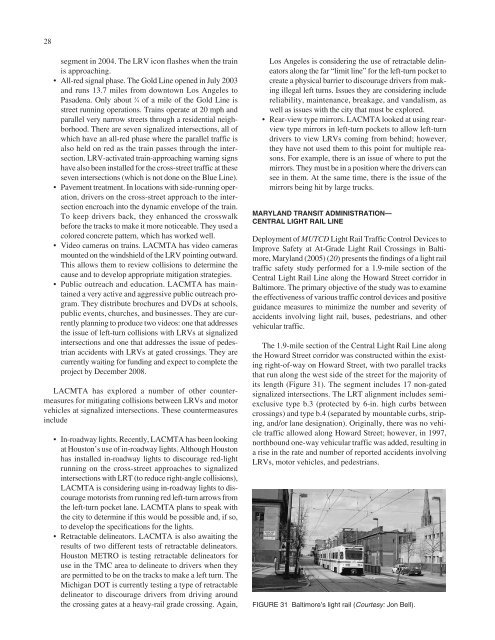Light Rail Vehicle Collisions with Vehicles at Signalized Intersections
Light Rail Vehicle Collisions with Vehicles at Signalized Intersections
Light Rail Vehicle Collisions with Vehicles at Signalized Intersections
- No tags were found...
Create successful ePaper yourself
Turn your PDF publications into a flip-book with our unique Google optimized e-Paper software.
28segment in 2004. The LRV icon flashes when the trainis approaching.• All-red signal phase. The Gold Line opened in July 2003and runs 13.7 miles from downtown Los Angeles toPasadena. Only about 3 ⁄4 of a mile of the Gold Line isstreet running oper<strong>at</strong>ions. Trains oper<strong>at</strong>e <strong>at</strong> 20 mph andparallel very narrow streets through a residential neighborhood.There are seven signalized intersections, all ofwhich have an all-red phase where the parallel traffic isalso held on red as the train passes through the intersection.LRV-activ<strong>at</strong>ed train-approaching warning signshave also been installed for the cross-street traffic <strong>at</strong> theseseven intersections (which is not done on the Blue Line).• Pavement tre<strong>at</strong>ment. In loc<strong>at</strong>ions <strong>with</strong> side-running oper<strong>at</strong>ion,drivers on the cross-street approach to the intersectionencroach into the dynamic envelope of the train.To keep drivers back, they enhanced the crosswalkbefore the tracks to make it more noticeable. They used acolored concrete p<strong>at</strong>tern, which has worked well.• Video cameras on trains. LACMTA has video camerasmounted on the windshield of the LRV pointing outward.This allows them to review collisions to determine thecause and to develop appropri<strong>at</strong>e mitig<strong>at</strong>ion str<strong>at</strong>egies.• Public outreach and educ<strong>at</strong>ion. LACMTA has maintaineda very active and aggressive public outreach program.They distribute brochures and DVDs <strong>at</strong> schools,public events, churches, and businesses. They are currentlyplanning to produce two videos: one th<strong>at</strong> addressesthe issue of left-turn collisions <strong>with</strong> LRVs <strong>at</strong> signalizedintersections and one th<strong>at</strong> addresses the issue of pedestrianaccidents <strong>with</strong> LRVs <strong>at</strong> g<strong>at</strong>ed crossings. They arecurrently waiting for funding and expect to complete theproject by December 2008.LACMTA has explored a number of other countermeasuresfor mitig<strong>at</strong>ing collisions between LRVs and motorvehicles <strong>at</strong> signalized intersections. These countermeasuresinclude• In-roadway lights. Recently, LACMTA has been looking<strong>at</strong> Houston’s use of in-roadway lights. Although Houstonhas installed in-roadway lights to discourage red-lightrunning on the cross-street approaches to signalizedintersections <strong>with</strong> LRT (to reduce right-angle collisions),LACMTA is considering using in-roadway lights to discouragemotorists from running red left-turn arrows fromthe left-turn pocket lane. LACMTA plans to speak <strong>with</strong>the city to determine if this would be possible and, if so,to develop the specific<strong>at</strong>ions for the lights.• Retractable deline<strong>at</strong>ors. LACMTA is also awaiting theresults of two different tests of retractable deline<strong>at</strong>ors.Houston METRO is testing retractable deline<strong>at</strong>ors foruse in the TMC area to deline<strong>at</strong>e to drivers when theyare permitted to be on the tracks to make a left turn. TheMichigan DOT is currently testing a type of retractabledeline<strong>at</strong>or to discourage drivers from driving aroundthe crossing g<strong>at</strong>es <strong>at</strong> a heavy-rail grade crossing. Again,Los Angeles is considering the use of retractable deline<strong>at</strong>orsalong the far “limit line” for the left-turn pocket tocre<strong>at</strong>e a physical barrier to discourage drivers from makingillegal left turns. Issues they are considering includereliability, maintenance, breakage, and vandalism, aswell as issues <strong>with</strong> the city th<strong>at</strong> must be explored.• Rear-view type mirrors. LACMTA looked <strong>at</strong> using rearviewtype mirrors in left-turn pockets to allow left-turndrivers to view LRVs coming from behind; however,they have not used them to this point for multiple reasons.For example, there is an issue of where to put themirrors. They must be in a position where the drivers cansee in them. At the same time, there is the issue of themirrors being hit by large trucks.MARYLAND TRANSIT ADMINISTRATION—CENTRAL LIGHT RAIL LINEDeployment of MUTCD <strong>Light</strong> <strong>Rail</strong> Traffic Control Devices toImprove Safety <strong>at</strong> At-Grade <strong>Light</strong> <strong>Rail</strong> Crossings in Baltimore,Maryland (2005) (20) presents the findings of a light railtraffic safety study performed for a 1.9-mile section of theCentral <strong>Light</strong> <strong>Rail</strong> Line along the Howard Street corridor inBaltimore. The primary objective of the study was to examinethe effectiveness of various traffic control devices and positiveguidance measures to minimize the number and severity ofaccidents involving light rail, buses, pedestrians, and othervehicular traffic.The 1.9-mile section of the Central <strong>Light</strong> <strong>Rail</strong> Line alongthe Howard Street corridor was constructed <strong>with</strong>in the existingright-of-way on Howard Street, <strong>with</strong> two parallel tracksth<strong>at</strong> run along the west side of the street for the majority ofits length (Figure 31). The segment includes 17 non-g<strong>at</strong>edsignalized intersections. The LRT alignment includes semiexclusivetype b.3 (protected by 6-in. high curbs betweencrossings) and type b.4 (separ<strong>at</strong>ed by mountable curbs, striping,and/or lane design<strong>at</strong>ion). Originally, there was no vehicletraffic allowed along Howard Street; however, in 1997,northbound one-way vehicular traffic was added, resulting ina rise in the r<strong>at</strong>e and number of reported accidents involvingLRVs, motor vehicles, and pedestrians.FIGURE 31 Baltimore’s light rail (Courtesy: Jon Bell).












